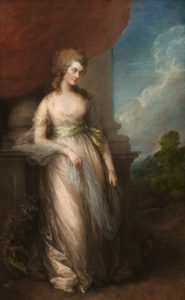In contrast to male homosexuality, same-sex female attraction in England has not been historically tainted with criminalisation. Referred to as the ‘silent sin’ by church authorities, it was thought that if kept out of popular consciousness, women would be unable to even think of same-sex relationships, let alone take part in them. As a result, the evidential trail for early modern lesbianism is considerably disadvantaged. However, one instance at which evidence of lesbianism and bisexuality emerges from the record is in the fashion for ambiguous romantic female friendships in the eighteenth century, alluded to in much literature of the time.

Georgiana Cavendish, née Spencer (1757-1806), or ‘Gee’, was linked to the most influential figures of the late 1700s, counting the Prince of Wales (later George IV), Charles Grey (later Prime Minister), Charles James Fox (Whig politician) and even French Queen Marie Antoinette in her circle of friends. As the wife of one of the nation’s richest men, she rocketed to celebrity, running up vast debts, immersing herself in political campaigns and establishing some of the most iconic fashions of the period. Georgiana’s private life was complex to say the least, and is the subject of much historiographical debate; despite her marriage and frequent heterosexual love affairs, such as with Early Grey, there is a wealth of evidence in her letters correspondence to suggest her affections were not limited to the male gender.
Her first female infatuation was with Mary Graham in 1777, a renowned beauty. Mary’s biographer Sarah Symmons has described Gee as ‘the love of her life’. Gee’s depth of feeling can be seen in her letters:
“You must know how tenderly I love you… I am falling asleep and must leave you now, but I want to say to you above all that I love you, my dear friend, and kiss you tenderly.”
Regrettably large sections of Mary’s letters have been blacked out, which some consider evidence of strong affection for Gee that her descendants wished to be concealed.
Further same-sex infatuation blossomed when Gee was introduced to Lady Elizabeth Foster in 1782, or ‘Bess’, estranged from her husband, lonely, and in financial dire straits. The two struck up an intense emotional bond, and Bess was invited to live with Gee, a situation which catalysed the beginning of a psychologically complex, and likely polyamorous ménage à trois between the two women and Gee’s husband, the Duke of Devonshire William Cavendish. This uneasy arrangement lasting twenty five years was a matrix of jealousy and blackmail between all parties, with Bess undermining Gee at every opportunity, and William fathering two illegitimate children with Bess. Though strained, the relationship between the two women was far from mere rivalry, and their sincere affection remained. Once again we can turn to letters:
“My dear Bess, Do you hear the voice of my heart crying to you? Do you feel what it is for me to be separated from you? … Oh Bess, every sensation I feel but heightens my adoration of you.”
When Gee died in 1806, Bess married her widower to become the new Duchess. Though this has been seen as the culmination of Bess’ scheme to usurp her friend’s social position, securing her reputation as a promiscuous mistress, we know that Bess deeply grieved this loss:
“[Georgiana] was the constant charm of my life. She doubled every joy, lessened every grief. Her society had an attraction I never met with in any other being. Her love for me was really ‘passing the love of woman.”
Of course we must be wary when retroactively applying anachronistic terms like ‘lesbian’ and ‘homosexual’ to figures like Georgiana, Elizabeth and Mary, and remember that the intensity of affection in their letters was not unique for the time. However, we are left wondering what Mary meant by ‘passing the love of woman’. There are conflicting interpretations of Georgiana’s personal relationships, however one cannot ignore that her passionate devotion to the women in her life is notable when considering the social implications of female same-sex relationships in this period.
Sources:
https://www.english-heritage.org.uk/learn/histories/lgbtq-history/romantic-female-friendship/
https://www.tatler.com/article/who-was-georgiana-spencer-duchess-of-devonshire
https://www.oxforddnb.com/view/10.1093/ref:odnb/9780198614128.001.0001/odnb-9780198614128-e-4934
